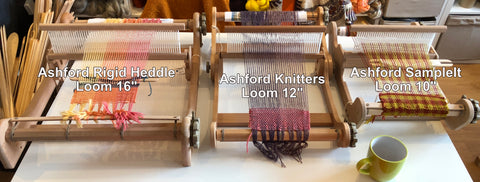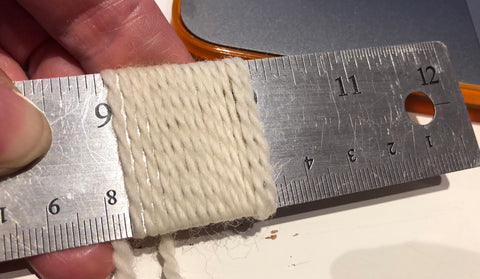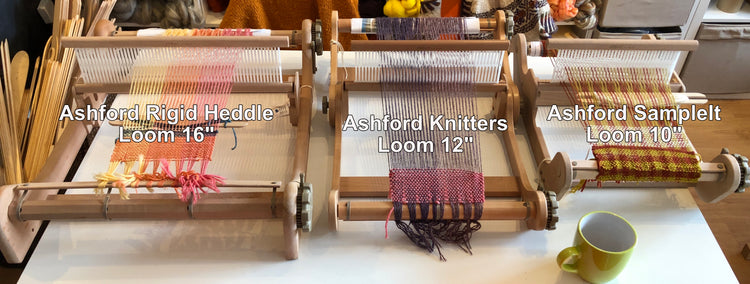Getting the right loom for a beginner weaver
So you've decided you've wanted to give weaving go and you think that a rigid heddle loom is for you but there's so many choices out there that you might not know which loom to choose.
Well, don't worry as in this blog post we're going to talk through what we recommend to new weavers when they are looking to get their first rigid heddle loom.
Choosing a loom is daunting as there are so many options. How wide do you want to weave? Do you want it to fold for travelling? Do you want two heddles (and why do you want two heddles)? How easy is it to use? What yarn do you need? How much will it cost? What do all these words like warp, weft, heddles, etc. mean?
What we'll do is go through all of this to help you understand it all and hopefully help you to choose the loom for you.
What does warp, weft, reed, heddles, and all this other stuff mean?
It's always good to start with the basics before going onto anything else. So here goes:
Warp - This is the yarn that you will measure and put onto your loom first and goes from the back to the front of the loom and through the heddle.
Weft - This is the yarn that you put in-between the warp yarns, usually using a shuttle. This is the yarn that goes from left to right and back again as you weave.
Reed - This is what the warp yarns are passed through as they go from the back to the front of the loom. The name Rigid Heddle for this type of loom comes from the main part of the reed that is usually made from plastic and has vertical slots and eyes cut in to it - this is the heddle. The warp yarns are alternately threaded through a slot or an eye in the heddle. When the heddle is lifted into an up position the eye warp yarns move to the top and the slot warp yarns are at the bottom. When the heddle is in a down position the slot yarns are up and the eye yarns are down. This basically mechanises the over under over under process you would have down with a needle and thread when weaving on cardboard at school. The heddle also spreads out the yarn and you can get different heddles for different yarn thicknesses.
Shuttle - The shuttle is the tool that the weft yarn is wound around and is then used to pass the weft yarn through the warp threads to help link the warp and weft threads together.
Shed - This is the gap between the upper and lower warp yarns and is where you pass your shuttle through with the weft yarns.
Warp beam - This is where the warp yarns are wound around before they have been made into cloth.
Cloth beam - This is where the handwoven cloth is wound around.
Cloth is what you make on a loom and the advantage of a rigid heddle loom is that you can make a couple of metres of cloth easily on these looms. You can then make anything from a scarf, table runner, bag, cushions, blankets, jumper, trousers, jackets or anything else from it really. Your handwoven cloth can be stitched to other handwoven cloth and even cut up to create more intricate patterns. So you could furnish your whole house and make all your own clothes with one loom. This brings us to the next question...
How wide a loom do I need?
This really depends on what you want to make.
We generally recommend a loom between 15"(38cm) to 25"(64cm) are good size to start with.
Smaller looms than this are great if you're just wanting to weave scarves, strips of fabric or just something small to transport and work well.
Looms larger than 25" can be daunting for beginners, unless you definitely know you are going to weave on these widths a lot then we suggest you're better sticking to something smaller.
You don't need to weave across the whole width of the loom at any time so on a 24" loom you can still weave a 10" wide fabric and then weave a 20" wide fabric another time.
The following photos give you an idea of the different sizes of the loom (other loom sizes are available) and the mug is to give you an idea of scale.

I really like the smaller sizes of looms such as the 15" Schacht Cricket and the 16" Ashford SampleIt as they are a nice and compact size and easily fit on your lap when you've got your feet up in front of the tv. They're a great size to start with and easy to store too.
We do find a lot of people think that bigger is better but this isn't always the case. For example the 32" rigid heddle loom seems to be popular for new weavers as their first loom but then they can feel intimidated by the size of it when they go to use it. Plus it's pretty big to move about and store.
Getting a smaller loom is less intimidating and you may find you will use it more, and you can always get a bigger size loom at a later date.
Do you want to travel with your loom?
The ability to be able to take your rigid heddle loom with you may be important in the decision of which loom to go for.
Hauling around a large loom can be done but may not be practical, especially if you need to use public transport.
The Schacht Cricket and Ashford SampleIt looms are nice and compact looms and you can get tote bags they fit into to take them with you.
The Ashford Knitters Loom and Schacht Flip looms have wider widths and are designed to fold so that you can take them with you, or fold for storing away. You can fold both of these looms in the middle of your weaving and then just open them up again to get weaving away.
Out of the two the Ashford Knitters Loom is more compact and folds up neatly and comes with a bag. You can get a bag for the Schacht Flip but it is a bit of a bigger loom. However, we find that the Flip does have better tension than the Knitters loom and the loom locks in place once it's in the weave position which helps to keep the loom shape.
You can take the standard Ashford Rigid Heddle Looms with you and a trusty blue Ikea bag can help to lug them around. Or, you could weave your own bag for it.
So, you can travel with all of them, but some are easier to travel with than others.
How easy are these looms to use?
They are really easy and straightforward to use!
Ashford have great tutorials on how to warp and weave on their rigid heddle looms and these methods work for the Schacht looms too.
You can have a lot of fun playing with different colours, types of yarns, thickness of yarns and even add in things like fibre, leaves and anything else you can find.
Once you've finished weaving just cut your cloth off your loom. You can knot or twist the ends to make a fringe to hold the yarns in place. Or, if you're going to be sewing the cloth you can overlock or zig zag stitch the edges.
Then, gently wash your fabric in warm water, rinse out and then iron out the creases whilst damp. Lay out flat to dry and then cuddle and love your own handwoven creation!
What yarn do you need?
You can use knitting yarns as well as cottons, linens, etc.
For the warp your yarn does need to have strength and little stretch as it's going to be under tension.
For the weft you can use anything, and that's anything from yarn to unspun fibre to leaves from your favourite plants.
You will need different reeds for different thicknesses of yarn and there are variable dent reeds where you can use more than one thickness of yarn at the same time.
All the yarn we sell at Weft Blown can be used on Rigid Heddle Looms and we recommend a DK weight wool to start off with, such as the Ashford Tekapo 8 ply, John Arbon Knit by Numbers or Eden Cottage Millburn DK, as these all work with a 7.5dpi/8dpi reed which comes with the looms.
What size reed do I need?
This depends on if you've got a yarn stash already and also what you want to weave.
Most looms come with a 7.5 dpi or 8 dpi reed. The dpi stands for dents per inch and basically is the number of warp threads going through a dent (slot/eye) in the reed.
To calculate what reed you need, wind your yarn around a ruler until you have wound an inch with the yarn sitting snugly.

In this photo there are 15 yarn wraps per inch (wpi). If you wove with 15 warp yarns in an inch with this yarn, there would be no space for the weft to be added in between the warp yarns. To get what's called a balanced weave, equal number of warp and weft threads, then we divide the wraps per inch number by 2. In this case that would be 7.5 warp threads/ends per inch (epi). Ends per inch is the same as dents per inch so you would need a 7.5 dpi or 8 dpi reed for this yarn.
Different reed sizes are used for different yarns and a rough guide for knitting yarns is below:
2.5 dpi = chunky yarn
5 dpi = Aran weight yarn
7.5 dpi = Double Knit weight yarn
10 dpi = Sportweight yarn
12.5 dpi = sock weight or 4ply
15 dpi = heavy lace weight
Always check your wraps per inch before starting any project as different types of yarn can give a different thickness of yarn.
What about this two heddle weaving?
You can do more patterns and weave two layers of cloth at the same time using two reeds (heddles) at once. This can be a bit faffy to set up but is fun. All the looms we sell have the ability to do this, you just need to have two reeds of the same dpi.
However, if you're thinking you want to do twills and double weave on a regular basis then do look at table looms like the Louët Erica as it is far easier to weave such techniques on a table loom than a rigid heddle loom.
How much does this all cost?
This depends on how large a loom you want, how many reeds and whether you want a stand.
The cheapest option are the Ashford SampleIt looms and they're great and affordable little looms.
If you're after something a bit bigger then the Ashford Rigid Heddle Looms are great for the price and you can get a wide loom for a decent price.
If money is no object then do look at the Schacht Flip as it's a great loom, and is lovely to weave on.
If you're thinking of getting a loom 20" or wider do think about getting a stand as it's easier to weave with a wider loom on a stand than propped against a table.
The cost of reeds is worth thinking about too as Ashford reeds are cheaper than Schacht reeds so if you're on a budget and know you'll need more reeds then do think about this too.
All the looms come with threading hooks, warping pegs (to help measure your warp), clamps to hold your loom steady when putting on the warp and instructions to get warped and weaving and two stick shuttles. The Schacht Cricket looms also come with yarn to get you going with your first project.
Are you ready to weave now?
We hope this has been useful and helps you to decide what rigid heddle loom may be the right one for you.
If it's made you more confused then don't worry as we're always here to help and do get in touch with us if you've got more questions.
Rigid Heddle weaving is great fun and we do hope this has helped you to get your own loom and then you can create your own magnificent handwoven cloth of your own.


